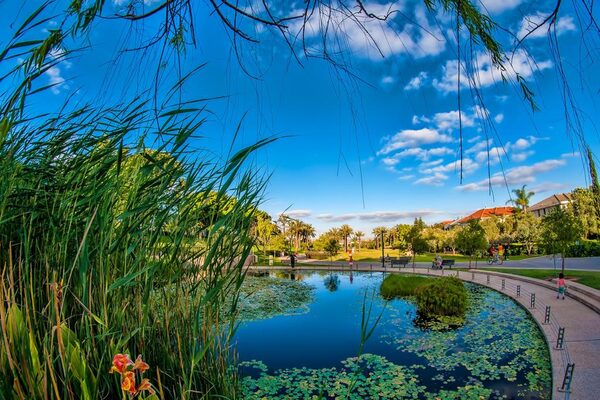Kfar Saba (Israel)
The relationship between the two cities dates back to the early 1970s, when the Wiesbaden Youth Welfare Office and Beit Berl College first established contact.
Worth knowing
Various contacts between the two cities culminated in a visit by a delegation from Wiesbaden in 1980. The then mayor of Kfar Saba, Zeev Geller, signaled his willingness to establish an official connection between the two cities. Following the adoption of the corresponding resolutions, the partnership agreement came into force in 1981 after the first joint signing in Kfar Saba. Due to scheduling problems, the counter-proclamation could only take place in Wiesbaden on May 25, 1983.
Wiesbaden's Israeli twin city is a young city. Many young families are helping to ensure that the population is growing steadily.Kfar Saba, which grew out of a small agricultural settlement, was founded in 1903. Today, Kfar Saba has more than 100,000 inhabitants. As host families, many of the young families help to maintain the original idea of this special form of civil encounters and thus continue the cultural exchange. The respective visitors live with host families and experience the everyday life of their hosts in the evenings and at weekends. During the day, the program includes tourist excursions as well as participation in joint memorial ceremonies, for example at Yad Vashem or the former Buchenwald concentration camp. Numerous close friendships between the residents of Wiesbaden and Kfar Saba have already developed from these civic encounters.
In addition, numerous cultural and educational contacts characterize the lively town twinning. Among other things, art exhibitions and concerts are organized. Ensembles from Israel have been guests at the International May Festival in Wiesbaden on several occasions and the Hessian State Theater Wiesbaden made guest appearances in Tel Aviv in 2005 and 2012.
In addition, there are joint youth camps as part of the Trinational Encounter of the Youth Welfare Office and regular student exchanges, for example between the Wiesbaden Carl von Ossietzky School and the Galili High School in Kfar Saba.
In addition to the partnership association "Freundeskreis Kfar Saba e.V.", the German-Israeli Society also supports the partnership with Kfar Saba. Among other things, the partnership association regularly organizes information events with interesting topics on Israel and the town twinning in Wiesbaden.
Kfar Saba extends over 5,766 hectares of green parks and plantings and has already won several awards for its exemplary environmental protection. Kfar Saba's green lung consists of over 101 hectares of green spaces and several interconnected parks. Of particular note is a huge city park in the heart of the city, which has many walking paths, an amphitheater, spacious lawns, playgrounds and ramps for extreme sports. The "Stele for Tolerance" by Wiesbaden artist Karl-Martin Hartmann was erected and inaugurated in this park in 2012.
The outstanding sights of the city of Kfar Saba include the Yad Labanim cultural center, the archaeology museum, the water tower and Kfar Saba Park. The origins of the settlement date back to the time of the second temple. This is evidenced by several mentions of the city in the Talmud as "Chabarzaba". The city's sights include the town hall and the central synagogue in Herzl Street. The Sapier Cultural Center with its focal point, the Yad Lebanim Cultural Hall, offers theater, music, dance and entertainment as well as performances by national and international artists. The water tower, whose observation hall offers a 360-degree panoramic view, offers an audiovisual presentation on the central and important issue of the local water supply.
Other recommended destinations from Kfar Saba include Tel Aviv, the coastal city of Haifa, Massada, the Dead Sea and the Negev Desert.
